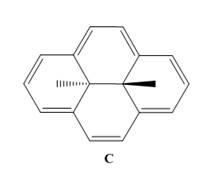
Concept explainers
Use the observed
aromatic. C shows
signals at
extent?

Want to see the full answer?
Check out a sample textbook solution
Chapter 17 Solutions
ORGANIC CHEMISTRY SOLUTION MANUAL
- Compound B has molecular formula C9H12. It shows five signals in the 1H-NMR spectrum - a doublet of integral 6 at 1.22 ppm, a septet of integral 1 at 2.86 ppm, a singlet of integral 1 at 5.34 ppm, a doublet of integral 2 at 6.70 ppm, and a doublet of integral 2 at 7.03 ppm. The 13C-NMR spectrum of B shows six unique signals (23.9, 34.0, 115.7, 128.7, 148.9, and 157.4). Identify B and explain your reasoning.arrow_forwardBased on its 13C NMR spectrum, how many types of nonequivalent carbons exist in benzonitrile and how many different types of aromatic (benzene) carbons can be seen in 13C NMR of benzonitrile?arrow_forward1) Propose the structures for the following 1H and 13C NMR spectra. a) Molecular Formula: C5H10O2 1H-NMR, CDCl3 Solvent, Molecular Formula: C5H10O2 13C-NMR, CDCl3 Solvent, Molecular Formula: C5H10O2 in the picturesarrow_forward
- The 1H NMR spectrum of bullvalene at 100 C consists only of a single peak at 4.22 . Explain.arrow_forwardThe compound with the 1H NMR spectrum shown is known to be highly reactive toward electrophilic aromatic substitution. Identify the compound.arrow_forwardHow many 1H NMR signals does the following isomer show?arrow_forward
- Propose a structure consistent with each set of data.a. a compound that contains a benzene ring and has a molecular ion at m/z = 107b. a hydrocarbon that contains only sp3 hybridized carbons and a molecular ion at m/z = 84c. a compound that contains a carbonyl group and gives a molecular ion at m/z = 114d. a compound that contains C, H, N, and O and has an exact mass for the molecular ion at 101.0841arrow_forwardThe compound whose 1H NMR spectrum is shown has the molecular formula C7H7Br. Follow the following questions to predict the unknown structure. 2(a) Degree of the unsaturation of this compound is= , 2(b) The two distinct peaks in the aromatic region of the 1H NMR indicate that compound is .................-disubstituted = 2(c) The splitting pattern of the peak at 2.31 δ is = 2(d) The group that corresponds to the splitting pattern in 1(c) is = 2(e) This compound has the plane of symmetry Yes or No = 2(f) The name of the unknown compound =arrow_forwardExplain why the cyclopentadienide anion A gives only one signal in its 13C NMR spectrum.arrow_forward
- Explain why the β carbon of an α,β-unsaturated carbonyl compound absorbs farther downfield in the 13 C NMR spectrum than the α carbon, even though the α carbon is closer to the electron-withdrawing carbonyl group. For example, the β carbon of mesityl oxide absorbs at 150.5 ppm, while the α carbon absorbs at 122.5 ppm.arrow_forward1) Propose the structures for the following 1H and 13C NMR spectrum. b) Molecular Formula: C8H8O3 1H-NMR, CDCl3 Solvent, Molecular Formula: C8H8O3 13C-NMR, CDCl3 Solvent, Molecular Formula: C8H8O3 in the picturesarrow_forwardAssume a compound with the formula C4H8O. a) How many double bonds and/or rings does your compound contain? b) If your compound shows an infrared absorption peak at 1715 cm-1, what functional group does it have? c) If your compound shows a single 1H NMR absorption peak at 2.1 δ, what is its structure?arrow_forward
